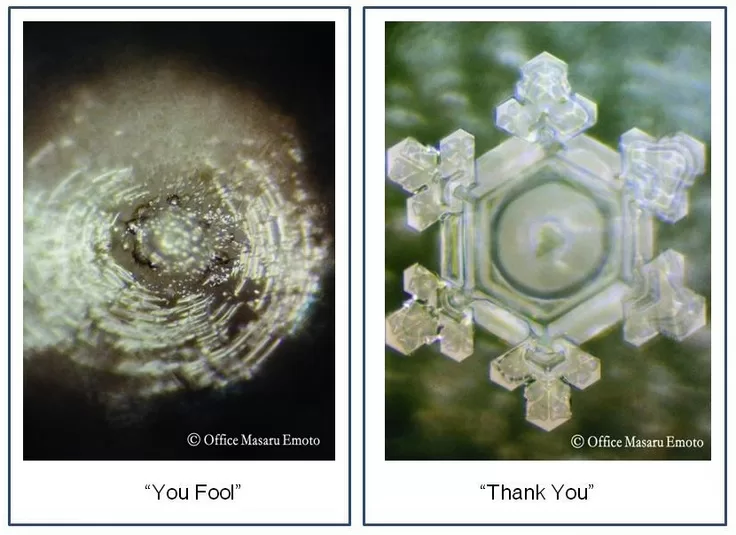
What if the words you speak could literally change the structure of matter around you? What if your emotions had the power to transform water at a molecular level? These questions might sound like science fiction, but they’re at the heart of some remarkable experiments that have sparked conversations worldwide.
The Experiment That Changed Everything
Dr. Masaru Emoto, a Japanese researcher, spent decades studying something most of us never think about: how water responds to human intention. His experiments were surprisingly simple yet profound in their implications.
Emoto would expose water samples to different words, music, or thoughts, then freeze the water and examine the resulting ice crystals under a microscope. What he discovered was that water exposed to positive speech and thoughts created visually pleasing ice crystals, while negative intentions yielded ugly, distorted formations.
Here’s how the process worked:
- Sample Collection: Emoto used distilled water from the same source
- Exposure: He would tape written words to containers, speak to the water, or play music near it
- Freezing: The water was flash-frozen at specific temperatures
- Photography: Using high-speed microscopic photography, he captured images of the crystal formations
The Results That Made People Think
The findings were striking. Water exposed to words like “love and gratitude” formed clear, beautiful, symmetrical crystals with hexagonal patterns. These crystals resembled the perfect snowflakes you might see in nature.
On the flip side, water exposed to negative words like “hate” or “you fool” produced fractured, asymmetrical crystals that looked chaotic and incomplete.
Even more fascinating was what happened with different water sources. Mountain stream water created beautifully shaped geometric designs when frozen, while polluted water sources formed distorted, randomly shaped ice structures.
Music had similar effects. Classical music and positive prayers directed at water produced beautiful crystals, while crude music like heavy metal produced ugly formations.
What We Can Learn for Our Lives
Regardless of the scientific debate, Emoto’s experiments offer powerful lessons about the quality of our communication and emotional energy:
Words Have Power
Whether or not water literally responds to our words, humans certainly do. The way we speak to others – and to ourselves – shapes relationships, self-esteem, and outcomes. If you’ve ever noticed how differently you feel after someone speaks kindly versus harshly to you, you understand this truth.
Intention Matters
Emoto found that the combination of “love and gratitude” produced the most beautiful crystals. He taught that love needs both giving and receiving – like the sun giving energy and the moon receiving it. This reminds us that our intentions behind our words and actions affect their impact.
Environment Shapes Us
Just as polluted water supposedly created distorted crystals, the “information environment” we expose ourselves to matters. The news we consume, the conversations we have, and the people we surround ourselves with all influence our mental and emotional state.
Our Bodies Are Mostly Water
Humans are approximately 60-70% water, similar to the percentage covering Earth. This fact alone makes us consider: if our thoughts and emotions can affect water, what might they be doing to our own bodies and well-being?
Practical Applications
You don’t need to believe in the literal transformation of water crystals to benefit from these insights:
Start Your Day with Gratitude: Instead of immediately checking your phone, spend a few minutes acknowledging what you’re grateful for.
Choose Your Words Carefully: Before speaking, especially in tense situations, ask yourself: “Will these words build up or tear down?”
Create Positive Environments: Surround yourself with uplifting music, inspiring books, and people who support your growth.
Practice Self-Compassion: The way you talk to yourself matters. Replace harsh inner criticism with the kind of encouragement you’d give a good friend.
Mindful Media Consumption: Emoto noted that water near cell phones and computers failed to form crystals unless labeled with positive messages. Consider taking regular breaks from negative news and social media.
The Bigger Picture
Whether or not Emoto’s specific claims about water hold up to scientific scrutiny, his work points to something most of us intuitively know: our words, emotions, and intentions have real effects on the world around us.
As Emoto himself said: “We have the ability to take an active part in the creation of our world. This realization gives us not only power, but also responsibility.”
The quality of our inner world – our thoughts, emotions, and intentions – inevitably shapes our outer world through our relationships, decisions, and actions. When we choose love over fear, gratitude over complaint, and encouragement over criticism, we’re not just changing water crystals – we’re changing lives.
In a world that often feels divided and harsh, maybe the simple act of speaking more kindly, thinking more gratefully, and approaching others with genuine love isn’t just nice – maybe it’s revolutionary.
How my wife Seema uses this knowledge
Seema regularly speaks to her plants in the balcony, especially the stubborn ones which take time to blossom! She addresses them with love and care. Now we might find it wierd but I know of at least one more person who speaks to the plants in her garden in Bangalore who does the same thing. Seema also talks to the crows and other birds who come to the window. I understand why now.. after all we are all atoms and molecules vibrating at a certain frequency.
Your Turn
Try this simple experiment: For one week, pay attention to the words you use when talking to yourself and others. Notice the difference between days when you focus on gratitude versus days when you focus on complaints.
You might not be able to photograph the changes in water crystals, but you’ll likely notice something even more important: the changes in yourself and the people around you.
What words will you choose to speak into existence today?